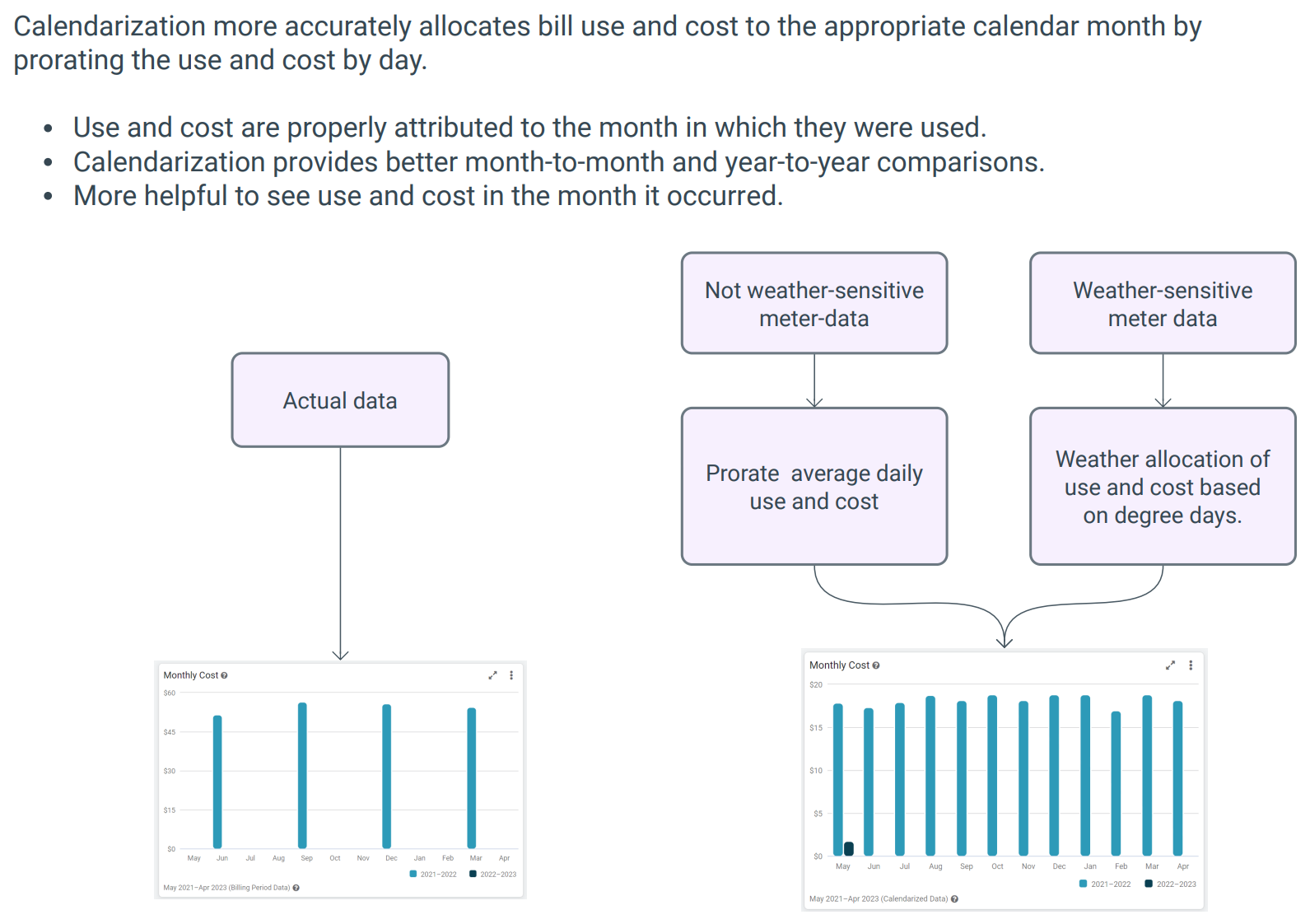Calendarization overview
Calendarization more accurately allocates utility bill use and cost to the appropriate calendar month by prorating the cost and use by day (dividing the data into day-size chunks and allocating to the appropriate month). Calendarization is required because most utility bills start and end dates don't correspond to the exact calendar month or may vary in length.
Using billing period data may not accurately reflect consumption and cost in the correct calendar month.
The weather regression calculations used by calendarization and normalization do not exclude statistical outliers. Cost Avoidance DOES exclude statistical outliers.
Why calendarize data?
When you calendarize data it aligns utility use and cost with the month it occurred, instead of the bill date. This approach is useful because it:
- Helps Energy Managers see energy use and cost when it actually happened.
- Supports better month-to-month and year-to-year comparisons.
- Improves accuracy for fiscal reporting, budgeting, accruals, and energy performance evaluation.
When not to calendarize:
Use actual bill dates instead if you need to:
- Discuss bills with a vendor.
- Reconcile with accounting systems.
- Charge tenants or departments based on actual billing dates.
User-defined calendarization
You can configure user-defined calendarization periods in the Accounts module menu.

How does calendarization happen?
- If the meters is not weather-sensitive, the data is prorated.
- A weather-sensitive meter incorporates degree day data to allocate use and cost.
Option 1 Simple average daily use and cost allocation
When a meter is not weather sensitive, the bill is simply prorated into each month based on the number of billing period days. A bill from 9/12 to 10/14 has 32 days (the first day counts, the last day doesn't because the next bill begins on 10/14). 19 days are in September, so 19/32 of the use and cost are allocated to September and 13/32 to October.
Option 2 Weather (degree day) allocation
When a meter is weather sensitive, a more sophisticated method is used to prorate the weather-sensitive portion of the energy bill based on the number of degree days in the appropriate billing period in each month, and to prorate the remaining, not weather-sensitive portion based on the number of days. See Use vs Weather for more details.
Calendarization does not appreciably affect annual totals because the process merely moves use and cost data to the most appropriate calendar month for reporting and analysis purposes. The annual use and cost totals should be almost identical to the billing period data.
Use vs Weather

Use vs Weather
- Summarizes weather sensitivity of a meter by season and year.
- Expand each row to view details metrics.
Key differences
- Calendarization and Cost Avoidance both assess weather sensitivity, but for different purposes.
- Calendarization uses global settings to assign weather sensitivity.
- Cost Avoidance uses meter-level settings and excludes statistical outliers for more refined analysis.
Each method supports different goals—accurate time-based reporting vs evaluating avoided energy costs.
Calendarization details
-
Uses the weather station assigned to the site (based on postal code or lat/long).
-
Weather regression is based on the previous year’s weather data.
-
Average use per day is calculated using the balance point temperature from the selected normalization year.
These settings improve accuracy when analyzing and comparing energy performance across time periods.

Defining statistical outliers
Statistical outliers are handled differently in the calendarization and normalization process than they are in Cost Avoidance.
In Cost Avoidance statistical outliers (those periodic use data points which fall more than two standard deviations away from the regression line defining a use/weather correlation for a meter) are handled as exceptions and are excluded from the weather adjustment process. This produces a better use vs. weather correlation using the remaining (non-excluded) bills.
In calendarization and normalization, the outliers are handled differently. These processes are less sophisticated and less calculation-intensive than Cost Avoidance. Outliers are included. If an outlier causes the regression to fail, it invalidates weather adjustments for that meter, that season, that year. If an outlier exists and the regression remains valid, the weather factors are applied to outlier bills and non-outlier bills.